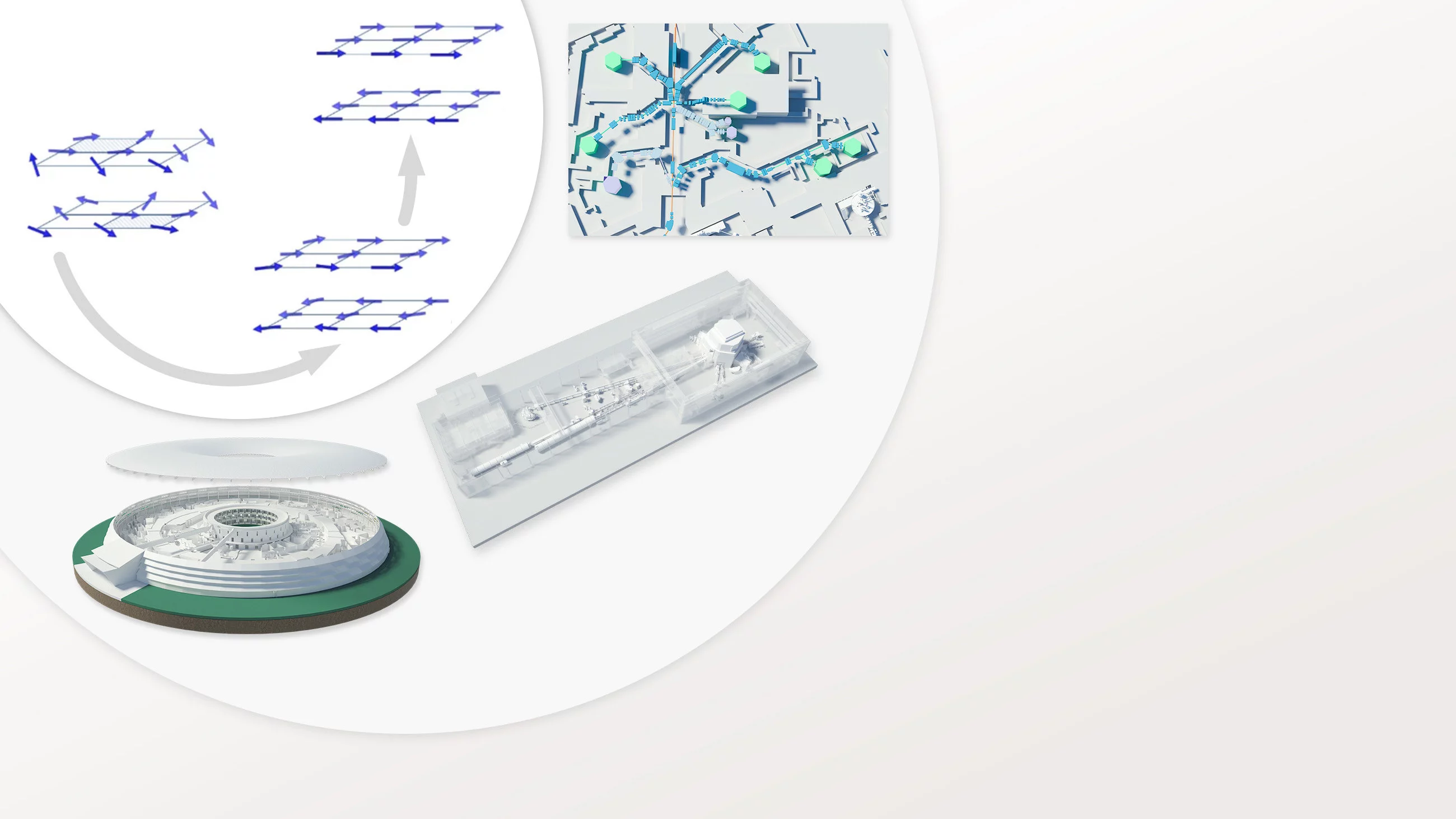Spins tick-tock like a grandfather clock and then stop. Thanks to complementary experiments at the Swiss Muon Source SµS, Swiss Spallation Neutron Source SINQ and the Swiss Light Source SLS, researchers led by the University of Geneva have discovered this coveted characteristic, known as magnetic crossover, hidden within the magnetic landscape of an exotic layered material. Magnetic crossover means tuneability and with it promise for spin-based electronics.
A two-dimensional layered material that is magnetic and a small band gap semiconductor? For the electronics of tomorrow, you could say that Chromium Sulfide Bromide (CrSBr) has it all. “Any new magnetic features that you can find in the material can be useful from a practical point of view”, says Zurab Guguchia, scientist in muon spin spectroscopy at PSI. Together with clues from two other of PSI’s large research facilities, this technique would reveal the highly sought-after trait of magnetic crossover in this exciting new material.
The researchers discovered that as CrSBr is cooled, magnetic fluctuations in the material – where the spins tick-tock back and forth like a grandfather clock - slow down and then freeze. This process is known as magnetic crossover. Interestingly, this is a gradual ‘crossover’ from one state to another, rather than a sharp transition that occurs at one temperature. And it is this characteristic that makes it such an appealing characteristic for spin based electronics devices, as Guguchia explains:
“We believe that this dynamic magnetic behaviour comes from competing interactions and frustrations that exist between the layers in the material. This means, with an external parameter we could tune it: push it in either direction. You couldn’t do this if it was just in one boring state.”
A very special van der Waals material with a magnetic secret
Recent years have seen a revolution in material science concerning the development of layered ‘van der Waals' materials. These materials consist of layers just a few atoms thick, within which particles such as electrons behave as if they are in a two-dimensional plane, exhibiting quirky quantum phenomena.
It is really a unique opportunity, to perform all three experiments - synchrotron X-ray diffraction, neutron diffraction, and muon spin relaxation - in one place here at the Paul Scherrer Institute. This allowed us to disentangle the magnetic and structural properties of this fascinating quantum material.
As scientists strive to discover new quantum materials, mixed-anion chemistry has become a promising route, as Fabian von Rohr, professor at the University of Geneva, explains. “By mixing different anions we can obtain materials exhibiting anisotropic properties [properties which vary depending on the direction in which they are measured] and control band gaps as well as magnetic interactions.”
The mixed-anion compound CrSBr in this regard caught the attention of von Rohr’s team, who focus on the discovery of new quantum materials, as a van der Waals material with strong magnetic properties, a highly layered structure, and anisotropic crystal chemistry in the individual layers. And it was this highly anisotropic crystal structure that led the researchers to suspect that CrSBr had secrets to reveal about its magnetic structure.
Studies of the material’s magnetic properties detected a long-range magnetic order. Yet, when cooled to 40 degrees Kelvin, the material’s magnetism subtly changed. This change was a tantalising hint of an unexplained magnetic transition: a so-called ‘hidden-order’.
Hidden orders can arise in quantum materials, where electrons, lattice vibrations, and magnetic moments are strongly entangled, leading to order and states that cannot be easily detected by standard probing techniques. To unravel this hidden-order, the researchers would need evidence from three large-scale research infrastructures of PSI – together on site at few other places in the world.
Three large research facilities together solve the mystery
There were several possibilities for this magnetic shift: a change in the crystal structure of the material, a change in the long-range magnetic structure or more exotic physics, i.e. a hidden order. To explore these possibilities, the scientists turned to the Swiss Muon Source SµS, Swiss Spallation Neutron Source SINQ and the Swiss Light Source SLS to probe the magnetic and structural properties of the material as it cooled.
“It is really a unique opportunity, to perform all three experiments - synchrotron X-ray diffraction, neutron diffraction, and muon spin relaxation - in one place here at the Paul Scherrer Institute,” emphasises postdoctoral researcher and first-author of the study Sara Lopez-Paz. “This allowed us to disentangle the magnetic and structural properties of this fascinating quantum material.”
Thanks to X-ray diffraction experiments at the Materials Science beamline of SLS, the team could confirm that there was no change in the material structure below 40K: a structural change was not the source of the unusual low-temperature state.
Through neutron diffraction at SINQ the researchers solved the magnetic structure of the material. This revealed a long-range magnetic order below 140 Kelvin. Yet, intriguingly, when the material was cooled further to 40 Kelvin, there was no further change to this structure.
Muons reveal the hidden-order
The explanation for this transition would come from muon spin spectroscopy at SµS, in which muons implanted into a material act as local probes of the magnetic field. Whereas neutron diffraction reveals the static magnetic state, this technique, available at just a handful of facilities worldwide, enables dynamic fluctuations in the magnetism to be observed.
Lopez-Paz points out that the techniques are complementary: “The combination of these state-of-the-art methodologies gives access to both static and dynamic interactions and allowed us to go from the local to the average order in CrSBr.”
The scientists observed that, in the magnetic state below 140 K, the spins were fluctuating. As the material was cooled, these spin fluctuations slowed down and froze completely at 40 K.
“We discovered that hidden below the long-range magnetic order, is this additional flavour to the magnetism,” says Guguchia. “This hidden-order could’ve been explained by various structural and magnetic reasons, which is why it was so important to have the evidence from the 3 facilities. In the end, the answer was magnetic crossover – which is even more interesting physics than one might at first expect!”
Text: Paul Scherrer Institute / Miriam Arrell
Contact
Dr. Zurab Guguchia
Laboratory for Muon Spin Spectroscopy
Research with Neutrons and Muons (NUM)
Paul Scherrer Institute, Forschungsstrasse 111, 5232 Villigen PSI, Switzerland
Telephone: +41 56 310 55 64
Email: zurab.guguchia@psi.ch
Prof. Dr. Fabian Von Rohr,
Laboratory for Quantum Materials Discovery
Department of Quantum Matter Physics (DQMP)
24 Quai Ernest-Ansermet, 1211 Genève 4, Switzerland
Telephone: +41 22 379 30 64
E-Mail: fabian.vonrohr@unige.ch
Original Publication
Dynamic magnetic crossover at the origin of the hidden-order in van der Waals antiferromagnet CrSBr
Sara A. López-Paz, Zurab Guguchia, Vladimir Y. Pomjakushin, Catherine Witteveen, Antonio Cervellino, Hubertus Luetkens, Nicola Casati, Alberto F. Morpurgo & Fabian O. von Rohr
Nature Communications, 12.08.2022
DOI: 10.1038/s41467-022-32290-4
Further Information
- Laboratory for Muon Spin Spectroscopy | LMU | Paul Scherrer Institut (PSI)
- SμS: Swiss Muon Source | SMUS | Paul Scherrer Institut (PSI)
- SINQ | SINQ | Paul Scherrer Institut (PSI)
- Swiss Light Source | SLS | Paul Scherrer Institut (PSI)
Funding
This research was supported by the Swiss National Science Foundation.
Copyright
PSI provides image and/or video material free of charge for media coverage of the content of the above text. Use of this material for other purposes is not permitted. This also includes the transfer of the image and video material into databases as well as sale by third parties.

